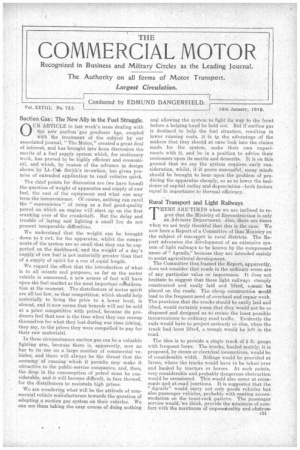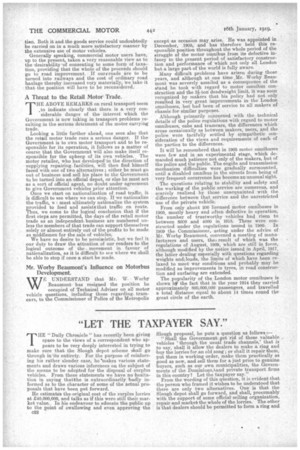Suction Gas: The New Ally in the Fuel Struggle.
Page 1

Page 2

If you've noticed an error in this article please click here to report it so we can fix it.
OUR ARTICLE in last week's issue dealing with the new suction gas producer has, coupled with the treatment of the subject by our associated journal, "The Motor," created a great deal of interest, and has brought into keen discussion the merits of a fuel supply system which, for stationary work, has proved to be highly efficient and economical, and which, by reason of the advance• in. design shown by Lt.-Cali. Sniith's invention, has given promise of extended application to road vehicles qiiick.
The chief points for discussion are (we have found) the question of weight of apparatus and supply of raw fuel, the cost of the equipment and what one may term the inconvenience. Of course, nothing can excel the " convenience " of using as a fuel good-quality petrol on which an engine will start up on the first cranking over of the crankshaft. But the delay and trouble of laying and lighting a small fire do not present insuperable difficulties.
We understand that the weight can be brought down to 2 cwt. for the apparatus, whilst the components of the system are so small that they can be supported on the dashboard, and the weight of a day's supply of raw fuel is not materially greater than that of a supply of spirit for a run of.equal length.
We regard the effect that the introduction of what is to all intents and purposes, so far' as the motor vehicle is concerned, a new source of fuel will have upon the fuel market as the most important cotsideration at the moment. The distributors of motor spirit are all too few, so that competition, which should help materially to bring the price to a. lower level, is absent, and it now seems that benzole will not be sold at a price competitive with 'petrol, because its producers feel that now is the time when they can recoup themselves for what they lost during war time (otwing, they say, to the prices they were compelled to pay for their raw materials).
In these circumstances suction gas can be a valuable fighting arm, because there is, apparently, now no bar to its use on a large number of commercial vehicles, and there will always be the threat that the economy of running which it permits may make it attractive to the public-service companies, and, then, the drop in the consumption of petrol must be considerable, and it will become difficult, in face thereof, for the distributors to maintain high prices.
We are wondering what will be the attitude of commercial vehicle manufacturers towards the question of adopting a suction gas system on their vehicles. We can see them taking the easy course of doing nothing and allowing the system to fight its way to the front before a helping hand be held out. But if suction gas is destined to help the fuel situation, resulting in lower running costs, it 'is to the advantage of the makers that they should at once look into the claims made for the system, make their own experiments with it, and be in a position to advise their customers'upon its merits and demerits. It is on this ground that we say the system requires early consideration, whilst, if it prove successful, many minds should be brought to bear upon the problem of producing the apparatus cheaply, so as to lower the incidence of capital outlay and depreciation—both factors equal in importance to thermal efficiency.
Rural Transport and Light Railwa” THERE ARE'TIM.ES when we arc inclined to regret that the Ministry of Reconstruction is only an Advisory Department. Also, there are times when we are truly thankful that this is the case. We now have a Report of a Committee of that Ministry on the subject of transprt in rural districts. The Report advocates the development of an extensive system of light railways to be known by the compressed name of" &grails," because they are intended mainly to assist agricultural development. The Committee that framed the Report, apparently, does not consider that roads in the ordinary sense are of any particular value or importance. It does not hesitate to suggest that these light railwaye cheaply constructed and easily laid and lifted, E....loule be placed on the roads. The cheap construction would lead to the frequent need of .overhaul and repair work. The provision that the trucks should be easily laid and lifted, would certainly mean that they would not be so disposed and designed as to creitte the least possible inconvenience to ordinary road traffic. Evidently the rails would have to project seriously or else, when the track had been lifted, a trough would be left in the road. , The idea.is to provide a single track of 2 ft. gauge with frequent. loops. The trucks, hauled mainly, it is proposed, by steam or electrical locomotives, would be of considevable width. Sidings would be provided at farms, where the trucks would have to be taken'over and hauled by tractors or horses. At such points, very considerable and probably dangerous obstruction would be occasioned. This would also occur at crossroads and at.road junctions. It is suggested that the " Agrails" would carry not only goods vehicles but also passenger vehicles, probably with seating accommodation on the toast-rack pattern. The passenger service would, we think, provide the minimum of comfort with the maximum of unpunetuality and ,obstruo tien. Both it and the goods service could undoubtedly be carried on in a much more satisfactory manner by the extensive use of motor vehicles.
Generally speaking, commercial motor users have, up to the present, taken a very reasonable view as to the desirability of consenting to some form of taxation, providing that the whole of the proceeds should go to road improvement. If our roads are to be turned into railways and the cost of ordinary road haulage thereby increased vary materially, we take it that the position will have to be reconsidered.
A Threat to the Retail Motor Trade.
THE ABOVE REMARKS on rural transport seem ,to indicate clearly that there is a very considerable danger of the interest which the Government is now taking in transport problems resulting in the serious detriment of the motor carrying trade.
Looking a little further ahead, one sees also that the retail motor trade runs a serious danger. If the Government is to own motor transport and to be responsible for its operation, it follows as a matter of course that the Government will also make itself responsible for the upkeep of its own vehicles. The motor retailer, who has developed'in the direction of supplying repairing, facilities, will then find himself faced with one of two alternatives ; either he must go out of business and sell his place to the Government to be turned into an official depot, or else he must act as a sort of official agent, no doubt under agreement to give Government vehicles prior attention. Once we start on nationalization of road traffic, it is difficult to see where we can stop. If we nationalize the traffic, a s must ultimately nationalize the system provided to feed and assisttsthat traffic en route. Thus, we come to the logical conclusion that if the first steps are permitted, the days of the retail motor trade as an independent, business are numbered unless the members of that trade can support themselves solely or almost entirely out of the profits to be made as middlemen for the sale of vehicles..
We have no desire to be pessimistic, but we feel it our duty to draw the attention of our readers to the logical outcome of the. movement in favour of nationalization, as it is difficult to see where we shall be able to stop if once a start be made.
Mr. Worby Beaumont's Influence on Motorbus Development.
WE UNDERSTAND that Mr. W. • Worby Beaumont has resigned the position he occupied of Technical Adviser on all motor vehicle questions, including those regarding, tramcars, to the Commissioner of Police of the Metropolis except as occasion may arise. Iles was appointed in December, 1905, and has therefore held • this responsible position throughout the whole period of the struggle of the motor omnibus from its defective infancy to the present period of satisfactory construction and performance of which not only all London but a large part of the world is fully aware.
Many difficult problems have arisen during those years, and although at one time ,Mr. Worby Beaumont was severely assailed as a consequence of the stand he took with regard to motor omnibus construction and the 3i-ton deadweight limit, it was soon recognized by makers that his policy had not only resulted in very great improvements in the London omnibuses, but had been of service to all makers of chassis for similar purposes.
Although primarily concerned with the technical details of the police regulations with regard to motor omnibuses, cabs and tramcars, the differences which arose occasionally as between makers, users, and the police were tactfully settled by sympathetic consideration of the views and requirements of each of the parties to the differences.
It will be rememberd that in 1905 motor omnibuses were few and in an experimental stage, which demanded much Patience not only of the makers, but of the police and the public. The engiAe and transmission mechanism difficulties were gradually surmounted, until a disabled omnibus in the streets from being of very frequent occurrence has become an unusual sight.
The questions relating to stability and safety and the working of the public service are numerous, and scareely realized by those unacquainted with the difference between that service and the unrestricted use of the private vehicle.
From' only about 200 licensed motor omnibuses in 1905, mostly heavy and often defective in operation, the number of trustworthy vehicles had risen to between 8000 and 4000 in 1918. These were constructed under the regulations issued in 1906In 1909 the Commissioner, acting under the advice of Mr. Worby Beaumont, convened a meeting of manufacturers and users, thes result of which was. the regulations of August, 1909, which are still in force, although modified by the notice issued in April, 1917, the latter dealing especially with questions regarding weights and;loa,ds, the limits of which have been relaxed to meet war conditions and probably may be modified as improvements in tyres, in road construction and surfacing are extended.
The popularity of the London motor omnibuses is shown 14' the fact that in the year 1914 they carried approximately 800,000,000 passengers, and travelled a total distance equal to about 14 times round the great circle of the earth.






















